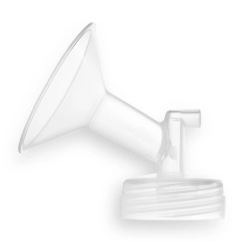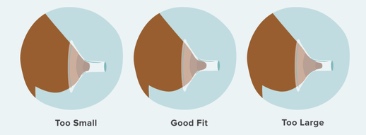
If pumping hurts, your milk output is low, or your nipple looks sore or swollen after a session, there’s a good chance your flange size might be off. And you’re not alone—this is one of the most common issues pumping moms run into, especially early on.
The good news? A properly fitting flange can make a big difference in both comfort and milk production. Here’s how to know if yours fits right and what to do if it doesn’t.
First, what is a flange?

The flange (also called a breast shield) is the part of the breast pump that fits over your nipple and areola. When the pump is on, it creates suction to draw milk out of the breast. If that piece doesn’t fit properly, it can lead to pain, irritation, or less milk than your body is capable of producing.
Most pumps come with a “standard” flange size—usually 24mm—but many moms need a size that’s smaller or larger. And flange fit can change over time, especially in the early postpartum weeks.
Signs Your Flange Might Be the Wrong Size

Here’s what to look for:
1. Your nipple rubs or stretches too much.
Your nipple should move freely inside the flange tunnel, without touching the sides or pulling in too much areola. Rubbing or tightness can cause soreness or damage.
2. Pumping is painful.
Pumping might feel strange at first, but it should not hurt. Pain is often a sign that your flange isn’t fitting properly.
3. Your nipple looks swollen, white, or misshapen after pumping.
If your nipple comes out looking pinched, blistered, or unusually swollen, your flange is likely too small or too large.
4. You’re not getting the milk you expect.
While milk supply depends on many factors, flange fit plays a big role. A poor fit can reduce stimulation and milk flow, even with a high-quality pump.
How to Find the Right Fit

To figure out your flange size, measure your nipple diameter in millimeters—not including the areola. It’s best to measure after a pumping session when your nipples are at their largest.
Once you have the measurement, you’ll want a flange that’s 1–3mm larger than your nipple diameter. For example, if your nipple measures 17mm, you’d likely need a 19mm–21mm flange.
Many pump brands now offer free sizing guides or printable tools, and some even sell more size options separately.
When in Doubt, Ask for Help
Finding the right fit can take a little trial and error, and it’s okay to ask for support. A lactation consultant can help you measure correctly and assess your flange fit during a session. If you’re a Matriarch client, we can help connect you with trusted resources to guide you in finding the right fit for your body.
Final Thoughts
A comfortable, well-fitting flange makes pumping more effective and a lot less stressful. If pumping hurts, doesn’t seem to be working well, or just feels off—check your flange size. It might be a small change that leads to a big difference.
Still have questions? Matriarch Health Supplies can guide you through sizing options and help you explore flange sizes that work for your pump and your body. You’re not in this alone.
You’ve got this, mama.


